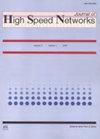基于葵花正弦余弦叠加自编码器的信任感知路由在WSN中进行脑电信号分类
IF 1
Q4 COMPUTER SCIENCE, INFORMATION SYSTEMS
引用次数: 0
摘要
信任感知路由是无线传感器网络安全路由协议设计的重要方向。实现了基于信任因子集的信任感知路由机制,对相邻节点的可信度进行评估。各种可信感知路由协议都是为了使数据路由的延迟最小而开发的,但是如何检测出高质量的路由是一个具有挑战性的问题。为此,设计了一种基于葵花正弦余弦(SFSC)堆叠自编码器的有效方法,利用WSN中的信任感知路由对EEG信号进行分类。此外,本文提出的SFSC算法结合了向日葵优化算法(SFO)和正弦余弦算法(SCA),给出了一个最优解,即脑电信号传输的最优路径。首先从网络环境中模拟的节点中计算信任因子,然后进行基于信任的路由,实现脑电信号的分类。本文提出的基于sfsc的堆叠自编码器通过基于能量、信任和距离等适应度参数选择最优路径获得了更好的性能。利用灵敏度、准确性和特异性等指标分析了该方法的性能。在150个节点的情况下,该方法的灵敏度、准确度和特异性分别达到94.708%、94.431%和95.780%。本文章由计算机程序翻译,如有差异,请以英文原文为准。
Trust aware routing using sunflower sine cosine-based stacked autoencoder approach for EEG signal classification in WSN
Trust-aware routing is the significant direction for designing the secure routing protocol in Wireless Sensor Network (WSN). However, the trust-aware routing mechanism is implemented to evaluate the trustworthiness of the neighboring nodes based on the set of trust factors. Various trust-aware routing protocols are developed to route the data with minimum delay, but detecting the route with good quality poses a challenging issue in the research community. Therefore, an effective method named Sunflower Sine Cosine (SFSC)-based stacked autoencoder is designed to perform Electroencephalogram (EEG) signal classification using trust-aware routing in WSN. Moreover, the proposed SFSC algorithm incorporates Sunflower Optimization (SFO) and Sine Cosine Algorithm (SCA) that reveals an optimal solution, which is the optimal route used to transmit the EEG signal. Initially, the trust factors are computed from the nodes simulated in the network environment, and thereby, the trust-based routing is performed to achieve EEG signal classification. The proposed SFSC-based stacked autoencoder attained better performance by selecting the optimal path based on the fitness parameters, like energy, trust, and distance. The performance of the proposed approach is analyzed using the metrics, such as sensitivity, accuracy, and specificity. The proposed approach acquires 94.708%, 94.431%, and 95.780% sensitivity, accuracy, and specificity, respectively, with 150 nodes.
求助全文
通过发布文献求助,成功后即可免费获取论文全文。
去求助
来源期刊

Journal of High Speed Networks
Computer Science-Computer Networks and Communications
CiteScore
1.80
自引率
11.10%
发文量
26
期刊介绍:
The Journal of High Speed Networks is an international archival journal, active since 1992, providing a publication vehicle for covering a large number of topics of interest in the high performance networking and communication area. Its audience includes researchers, managers as well as network designers and operators. The main goal will be to provide timely dissemination of information and scientific knowledge.
The journal will publish contributed papers on novel research, survey and position papers on topics of current interest, technical notes, and short communications to report progress on long-term projects. Submissions to the Journal will be refereed consistently with the review process of leading technical journals, based on originality, significance, quality, and clarity.
The journal will publish papers on a number of topics ranging from design to practical experiences with operational high performance/speed networks.
 求助内容:
求助内容: 应助结果提醒方式:
应助结果提醒方式:


